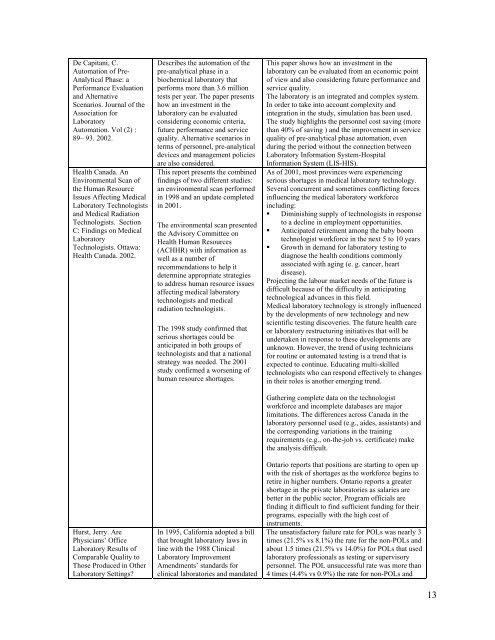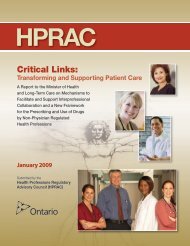Scope Of Practice Review - Health Professions Regulatory Advisory ...
Scope Of Practice Review - Health Professions Regulatory Advisory ...
Scope Of Practice Review - Health Professions Regulatory Advisory ...
You also want an ePaper? Increase the reach of your titles
YUMPU automatically turns print PDFs into web optimized ePapers that Google loves.
De Capitani, C.Automation of Pre-Analytical Phase: aPerformance Evaluationand AlternativeScenarios. Journal of theAssociation forLaboratoryAutomation. Vol (2) :89– 93. 2002.<strong>Health</strong> Canada. AnEnvironmental Scan ofthe Human ResourceIssues Affecting MedicalLaboratory Technologistsand Medical RadiationTechnologists. SectionC: Findings on MedicalLaboratoryTechnologists. Ottawa:<strong>Health</strong> Canada. 2002.Hurst, Jerry. ArePhysicians’ <strong>Of</strong>ficeLaboratory Results ofComparable Quality toThose Produced in OtherLaboratory Settings?Describes the automation of thepre-analytical phase in abiochemical laboratory thatperforms more than 3.6 milliontests per year. The paper presentshow an investment in thelaboratory can be evaluatedconsidering economic criteria,future performance and servicequality. Alternative scenarios interms of personnel, pre-analyticaldevices and management policiesare also considered.This report presents the combinedfindings of two different studies:an environmental scan performedin 1998 and an update completedin 2001.The environmental scan presentedthe <strong>Advisory</strong> Committee on<strong>Health</strong> Human Resources(ACHHR) with information aswell as a number ofrecommendations to help itdetermine appropriate strategiesto address human resource issuesaffecting medical laboratorytechnologists and medicalradiation technologists.The 1998 study confirmed thatserious shortages could beanticipated in both groups oftechnologists and that a nationalstrategy was needed. The 2001study confirmed a worsening ofhuman resource shortages.In 1995, California adopted a billthat brought laboratory laws inline with the 1988 ClinicalLaboratory ImprovementAmendments’ standards forclinical laboratories and mandatedThis paper shows how an investment in thelaboratory can be evaluated from an economic pointof view and also considering future performance andservice quality.The laboratory is an integrated and complex system.In order to take into account complexity andintegration in the study, simulation has been used.The study highlights the personnel cost saving (morethan 40% of saving ) and the improvement in servicequality of pre-analytical phase automation, evenduring the period without the connection betweenLaboratory Information System-HospitalInformation System (LIS-HIS).As of 2001, most provinces were experiencingserious shortages in medical laboratory technology.Several concurrent and sometimes conflicting forcesinfluencing the medical laboratory workforceincluding:• Diminishing supply of technologists in responseto a decline in employment opportunities.• Anticipated retirement among the baby boomtechnologist workforce in the next 5 to 10 years• Growth in demand for laboratory testing todiagnose the health conditions commonlyassociated with aging (e. g. cancer, heartdisease).Projecting the labour market needs of the future isdifficult because of the difficulty in anticipatingtechnological advances in this field.Medical laboratory technology is strongly influencedby the developments of new technology and newscientific testing discoveries. The future health careor laboratory restructuring initiatives that will beundertaken in response to these developments areunknown. However, the trend of using techniciansfor routine or automated testing is a trend that isexpected to continue. Educating multi-skilledtechnologists who can respond effectively to changesin their roles is another emerging trend.Gathering complete data on the technologistworkforce and incomplete databases are majorlimitations. The differences across Canada in thelaboratory personnel used (e.g., aides, assistants) andthe corresponding variations in the trainingrequirements (e.g., on-the-job vs. certificate) makethe analysis difficult.Ontario reports that positions are starting to open upwith the risk of shortages as the workforce begins toretire in higher numbers. Ontario reports a greatershortage in the private laboratories as salaries arebetter in the public sector. Program officials arefinding it difficult to find sufficient funding for theirprograms, especially with the high cost ofinstruments.The unsatisfactory failure rate for POLs was nearly 3times (21.5% vs 8.1%) the rate for the non-POLs andabout 1.5 times (21.5% vs 14.0%) for POLs that usedlaboratory professionals as testing or supervisorypersonnel. The POL unsuccessful rate was more than4 times (4.4% vs 0.9%) the rate for non-POLs and13
















